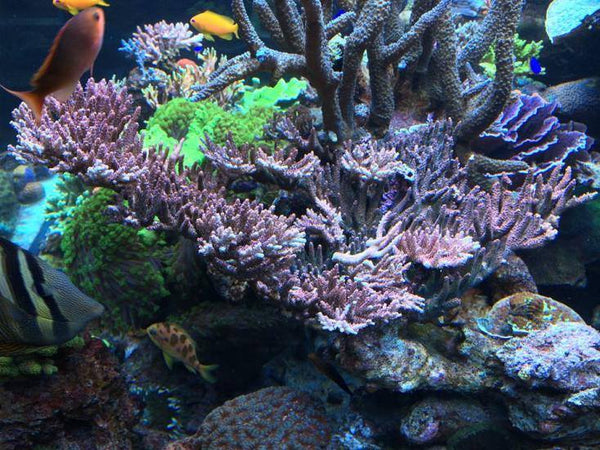- Continue Shopping
- Your Cart is Empty
Don't sweat it.
As an experienced aquarist, you've no doubt had all of those "unexpected", unfortunate, or otherwise unwelcome things happen in your tanks, right?
You know, stuff like algae on the rocks or wood, or substrate that gradually develops a "patina" of algae on it.
You know, stuff that just "happens" in aquariums over time.
Stuff a lot of hobbyists tend to stress out over. Stuff that freaks some of us out!
I'm here to tell you- don't sweat it. Really.
The biggest "buzzkill" for almost every hobbyist who's ever lived is algae. Far and away, the number one stress-causing, mind-blowing, blood-pressure-raising issue for most hobbyists is the appearance of algae. To us, a little algae means that this weird "chain reaction is gonna happen and pretty soon, your entire tank will be overrun by a carpet of nastiness!

Now, for a lot of hobbyists, even some algae is seen as a sign that your system is "out of balance", with perhaps an excess of nutrients accumulating somewhere in the system. Obviously, this is a superficially correct observation. The occurrence of algae means that there is sufficient nutrient in the aquarium to fuel its growth. Duh.

Yet, what is that always a bad thing? Algae is among the oldest, most adaptable life forms on the planet, and will exploit every available opportunity to flourish. It's consuming some of the nutrient that you don't want accumulating in the first place! It's beneficial in many cases, as it is an efficient processor of organics, produces oxygen, serve as food for many aquatic creatures and provides a "substrate" for small crustaceans and other life forms which our fishes consume as part of their diet. When you think about it, the appearance of algae in the aquarium is actually an indicator that thing are functioning pretty well!
There's a lot to like about algae, if you really think about it.
Sure, the "dark side" to algae is that it can smother your plants and cover everything if left unchecked. Now, that IS the sign of an unbalanced aquarium, when it's growing faster than your plants, or literally taking over every surface. Yet, some growth of algae on rocks and wood is not only not cause for alarm, it's really a natural and almost inevitable thing.

Yet, we have been trained over the century or so that we've been keeping aquariums to loathe the appearance of algae; to fear it and take drastic action when we see it. The bulk of the algae "problem", IMHO, is in our minds. It's that it's been perceived as an affront to our aesthetics in the "popular" hobby, because we've been told that an aquarium should appear near "sterile", or at least, devoid of any growth that we think is "unattractive." And I think that's kind of sad.
Of course, aquarist who keep Mbuna will tell you algae and overgrowth of associated microorganisms, or "aufwuchs"- is simply part of the game, as it's a natural and necessary part of these fishes' environment. It's not seen as "ugly"- it's seen as necessary. And its appearance in the aquarium is considered a sign of success!

Marine aquarists as well celebrate the appearance of coralline and other algae as a sign that their system is operating naturally and efficiently. You should, too!

The reality is, algae growth is important. It's seen everywhere on the planet, and it's all over rocks, wood, and other submerged objects in natural watercourses. It's part of the rich fabric of life. Accepting that some algae is not only acceptable, but actually aesthetically interesting will take a "mental shift"- along the lines of the one that we make when we embrace a botanical/blackwater aquarium and its accompanying tinted water, decomposing botanicals, and biofilms.
It's actually not only "part of the aesthetic" of underwater habitats, it's part of the necessary ecological framework.

And that makes it a beautiful thing.
So, next time you notice a little algae film here and there in your tank, don't run off in a panic and reach for the algicide. Look at it and ask yourself if it's really "taking over" the tank,smothering your plants- or just exploiting a niche that's available to it. Ask yourself if it's becoming a burden or danger to the fishes, or simply a "distraction" that you've been accustomed to fearing and reviling throughout your aquarium "career."

Sure, if it's growing unchecked, you'll want to bring it under control. But if it's simply growing in different places in the aquarium, consider this a natural, normal part of an underwater ecosystem. Take a look at some natural underwater habitats and consider its role there. And appreciate the natural, unique aesthetic that it brings.
Is it really so bad?
No, it really isn't.
Don't sweat it.
So says the guy who loves brown water, decomposing leaves, and biofilms in his tanks.

Well, just think about it, okay?
Stay calm. Stay open-minded. Stay curious.
And Stay Wet.
Scott Fellman
Tannin Aquatics









Scott Fellman
Author